Systematic Treatments
L. formosa (Vogel) Koehne
Lespedeza formosa (Vogel) KoehneDeutsche Dendrol., 343 (1893), excl. syn. Desmodium racemosum Sieb. et Zucc., L. Sieboldii Miq.-Schindler in Engl., Bot. Jahrb. 49: 580 (1913), excl. syn. Desmodium racemosum Sieb. et Zucc., L. racemosa Sieb. herb. ex Miq., L. Sieboldii Miq., L. bicolor (non Turcz.) Maxim. var. typica (p.p.), L. bicolor Turcz. var. Sieboldii (Miq.) Maxim., L. cyrtobotrya Miq. (p.p.), Desmodium penduliflorum Oudem. et var. albiflora Schindl.; in Sargent, Pl. Wils. 2: 107 (1914), pro parte-Fu in Acad. Sin. Bot., Ill. Important Chin. Pl. Leguminosae, 519 (1955), pro parte, excl. syn. L. Thunbergii (DC.) Nakai-Hatusima in Mem. Fac. Agr. Kagoshima Univ. 6: 7 (1967), pro parte, excl. f. sericea Hatusima, f. versicolor (Nakai) Hatusima, f. albiflora (Sieb. in sched ex Miq.) Hatu-sima, var. shiroyamensis (Hatusima) Hatusima e t syn. L. japonica L. H. Bailey, L. nipponica Nakai-Acad. Sin. Bot., Iconogr. Cormophyt. Sin. 2: 459, fig. 2647 (1972), pro parte, excl. syn. L. Thunbergii (DC.) Nakai-Akiyama & Ohba in Ohba & Malla, Himal. Pl. 1:225(1988). A perennial plant, 0.5-2 m high. Stems ascending or not distinct, branched in upper part or many branches coming from the basal parts of stem and underground parts. Branches terete, ascending, sometimes spreading, when young slightly angular with densely ascending appressed-sericeous or spreading hairs (hairs 0.2-0.3 mm long, whitish), later glabrescent; distal parts die in winter season, proximal parts (and stem) with axillary and adventitious winter buds. Leaves trifoliolate, petiolate, stipulate, spirally arranged. Stipules free, linear-triangular to linear, 2-7 mm long, brownish, persistent. Petioles 1-5 cm long, hairy like the young branch. Rachides 5-15 mm long, similar to the petiole. Terminal leaflets (at middle parts of branches) petiolulate; petiolules 1-3 mm long, swollen; lamina 2-6 cm long, 1.5-3.5 cm wide, entire, elliptic to ovate, round at the base, acute or obtuse at the apex (the apex itself with or without a point), upper surface glabrous or pubescent, lower surface appressed-sericeous (hairs 0.2-0.3 mm long); lateral ones similar to terminal but somewhat smaller. Inflorescence axillary racemous, one (rarely 2-3) per axil, 2-15 cm long including the peduncle, loosely or compactly 4-14-flowered; peduncles 1-2 cm long, hairy like the young branch. Primary bracts ovate, about 1 mm long, pubescent, persistent; secondary bracts similar to primary ones. Flowers 10-15 mm long at anthesis; pedicels 1-3 mm long, terete, curved, tomen-tose. Bracteoles at the base of the calyx broadly to narrowly ovate or obtuse, ca. 1 mm long, pubescent outside, glabrous inside, persistent. Calyx 3.5-6 mm long, cannpanu-late, four-lobed above or near the middle part, appressed pubescent; lateral one triangular with acute apex; upper one slightly two-clefted. Standard nearly equal to, longer or shorter than keel-petal, keel-petal longer than wings. Standard red-purple inside, paler outside, 9.5-13.5 mm long with distinct claw; lamina (broadly to narrowly) elliptic, round or retuse at the apex with or without a point, inflexed-auriculate near the base, reflexing in anthesis from the part near the base; claw whitish. Wings deeper red-purple than standard, 8.5-10.5 mm long with distinct claw; lamina narrowly (to broadly) obovate to oblong, auriculate at upper basal part, slightly auriculate or tapering at the lower basal part; claw whitish. Keel-petal 10.5-13.5 mm long with distinct claw; lamina narrowly obovate, paler than wings, deepest in the apical part; claw whitish. Ovary elliptic, ca. 1.5 mm long at anthesis, pubescent, stalked; stalk ca. 1.5 mm long. Fruits compressed (broadly) elliptic, 7-12 mm long, 4-5 mm wide, densely to slightly pubescent (or nearly glabrous), stalked; stalk 1.5-2 mm long. Distr. E. Himalayas, China, Korea, Taiwan, and Japan. Our previous paper deals with this species (Akiyama & Ohba, 1988). This species has the widest range in sect. Macrolespedeza (Japan to E. Himalayas through Korea, Taiwan, and China) and shows remarkable geographical variation in the shape of calyx-lobes, and in the relative length of corolla to calyx and calyx-lobe to calyx-tube. Three subspecies are recognized: subsp, formosa from S.E. China, Hong Kong, Macao, and Taiwan; subsp. elliptica from S.W. China and Assam; and subsp. velutina from Japan, Korea, and E. China.
Subsp. formosa: S. Akiyama & H. Ohba in Ohba & Malla, Himal. Pl. 1: 225 (1988). Japanse name. Taiwanhagi (Hatusima, 1969). Further synonyms and specimens examined are cited in Akiyama & Ohba (1988). Distr. S.E. China, Hong Kong, Macao, and Taiwan. Subup. elliptica (Benth. ex Maxim.) S. Akiyama et H. Ohba in H. Ohba & Malla, Himal. Pl. 1:226(1988). Distr. S.W. China and Assam. Further synonyms and specimens examined are cited in Akiyama & Ohba (1988). Subsp. velutina (Nakai) S. Akiyama et H. Ohba in H. Ohba & Malla, Himal, Pl. 1:227(1988).[Plate 15-17; Fig. 42]
L. bicolor Turcz. var. velutina Nakai in Bot. Mag. Tokyo 37: 74 (1923). L. kiusiana Nakai, Lesp. Jap. Korea, 26 (1927)-Akiyama & Ohba in Journ. Jap. Bot. 61: 96 (1986). L. intermedia Nakai, Veg. Mt. Chirisan56 (1915); in Bot. Mag. Tokyo 37: 76 (1923), non Britt. (1893). L. intermedia Nakai var. angustifolia Nakai in Bot. Mag. Tokyo 37: 77 (1923). L. maritima Nakai in Bot. Mag. Tokyo 37: 78 (1923). L. japonica L. H. Bailey var. intermedia (Nakai) Nakai, Lesp. Jap. Korea, 23 (1927) -Lee in Bull. Seoul Nat. Univ. For. No. 2, 15 (1965). L. japonica L. H. Bailey var. angustifolia (Nakai) Nakai, Lesp. Jap. Korea, 25 (1927). L. japonica L. H. Bailey var. retusa Nakai, Lesp. Jap. Korea, 26 (1927). L. Uekii Nakai in Bot. Mag. Tokyo 42: 457 (1928). L. japonica L. H. Bailey var. spicata Nakai in Journ. Jap. Bot. 15: 533 (1939). L. tetraloba Nakai in Journ. Jap. Bot. 15: 680 (1939). L. penduliflora Oudem. var. albiflora (Sieb. ex Miq.) Ohwi f. angustifolia (Nakai) Ohwi, Fl. Jap., 679 (1953), nom. nud. L. Thunbergii (DC.) Nakai var. albiflora (Schneid.) Ohwi f. angustifolia (Nakai) Ohwi, Fl. Jap. rev. ed., (790) 1438 (1965); Fl. Jap. Eng. ed., 559 (1965), ut "L. Thun-bergii (DC.) Nakai f. angustifolia (Nakai) Ohwi"; Fl. Jap. new ed., 790 (1975). L. japonica L. H. Bailey var. intermedia Nakai f. retusa (Nakai) T. Lee in Bull. Seoul Nat. Univ). For. No. 2, 17 (1965). L. maritina Nakai f. Uekii (Nakai) Hatus. in Mem. Fac. Agr. Kagoshima Univ. 6: 10 (1967). L. Thunbergii (DC.) Nakai var. intermedia (Nakai) T. Lee in Bull. Seoul Nat. Univ. For. No. 6, 56 (1969). L. Thunbergii (DC.) Nakai var. intermedia (Nakai) T. Lee f. retusa (Nakai) T. Lee in Bull. Seoul Nat. Univ. For. No. 6, 56 (1969). L. japonica L. H. Bailey f. angustifolia (Nakai) Murata in Acta Phytotax. Geobot. 29: 100 (1978)-Ohashi in Satake et al., Wild Fl. Jap. 2: 205 (1982). Japanese name. Bitchu-yamahagi (Nakai, 1923), Chosen-yamahagi (Nakai, 1923). A perennial plant, 1.5-2 m high. Stems ascending, 0.5-1 m high, 1-3 cm in diameter; most of the terrestrial part lives only a few years; branched in upper parts (a few branches coming from the basal part of the stem). Branches terete, ascending, sometimes dependent later; when young slightly angular with densely ascending appressed-sericeous hairs (hairs 0.2-0.3 mm long, whitish), later glabrescent; distal parts die in winter, proximal parts (and stem) with axillary and adventitious winter buds (winter buds at lower parts mostly dormant). Leaves trifoliolate, petiolate, stipulate, spirally arranged. Stipules free, linear-triangular to linear, 2-7 mm long, brownish, persistent. Petioles 1-5 cm long, hairy like the young branch. Rachides 5-15 mm long, similar to the petiole. Terminal leaflets (at middle parts of branches) petiolulate; petiolules 1-3 mm long, swollen; lamina 2-6 cm long, 1.5-3.5 cm wide, entire, elliptic to ovate, cuneate, or round at the base, acute or obtuse at the apex (the apex itself with or without a point), upper surface pubescent (hairs 0.1-0.15 mm long, usually more than 40/mm2), lower surface ap-pressed-sericeous (hairs 0.2-0.3 mm long); lateral ones similar to terminal but somewhat smaller. Inflorescence axillary racemous, one (rarely 2-3) per axil, (2-)4-10(-15) cm long including the peduncle, somewhat loosely to loosely 6-14-flowered; peduncles 1-4 cm long, hairy like the young branch. Primary bracts ovate about 1 mm long, pubescent, persistent; secondary bracts similar to primary ones. Flowers in middle September to middle October, 11.7-12.8 mm long at anthesis; pedicels 1.5-3 mm long terete, curved, tomentose. Bracteoles at the base of the calyx broadly to narrowly ovate or obtuse, ca. 1 mm long, pubescent outside, glabrous inside, persistent. Calyx 3.9-4.4 mm long, campanulate, four-lobed above the middle part, appressed pubescent; tube 1.6-1.7 mm long; the lower lobe longest; lateral ones 2.2-2.7 mm long, 0.8-1.1 mm wide, triangular-lanceolate, acute at the apex but not acuminate; upper ones slightly two-clefted. Standard nearly equal to keel-petal, keel-petal longer than wings (S≥K>W). Standard red-purple inside, paler outside, 10.7-12.4 mm long with distinct claw, 6.0-7.2 mm wide; lamina (broadly to narrowly) elliptic to obovate, round or retuse at the apex with or without a point, inflexed-auriculate near the base, reflexing in anthesis from the part near the base; claw whitish, 2.0-2.4 mm long. Wings deeper red-purple than standard, 8.6-10.1 mm long with distinct claw: lamina narrowly obovate to oblong, 6.0-7.3 mm long, 2.0-3.2 mm wide, auriculate at upper basal part, slightly auriculate or tapering at the lower basal part; claw 2.9-3.4 mm long, whitish. Keel-petal 10.5-12.0mm long with distinct claw; lamina narrowly obovate, 7.4-8.6 mm long, 3.2-3.7 mm wide, paler than wings, deepest in the apical part; claw 3.1-3.6 mm long, whitish. Stamens 10, nearly the same length, 10-11.5 mm long, diadel-phous. Anthers elliptic, shallowly retuse at the apex, ca. 0.6 mm long; before anthesis yellow. Pistils 11.5-12 mm long; ovary elliptic, ca. 1.5 mm long at anthesis, pubescent, stalked; stalk ca. 1.5 mm long; style 7-8.5 mm long, pubescent at the basal part, glabrescent at the apical part. Fruits compressed (broadly) elliptic, 7-8(-9) mm long, 4-5 mm wide, densely to slightly pubescent (or nearly glabrous), stalked; stalk 1.5-2 mm long. Seeds reniform, 3-3.5 mm long, 2-2.5 mm wide. Distr. Japan (W. Honshu and N. Kyushu), Korea, and E. China. Voucher and representative specimens. Japan. HONSHU. SHIZUOKA. Iwata-gun, Sakuma-mura, Urakawa-Kawakami (Torii 14312 & 28 Sept. 1958, KYO); Mt. Ogasa-yama (Shimizu, 13 Oct. 1929, KYO). AICHI. Miwamura, Ikebasaka (Torii, 6 Sept. 1959, KYO); Goten-mura (Torii 6156, KYO); Noda-mura (Torii 617, TUSG); Kamitsugu-mura, Orimoto-touge (Torii 6110, TUSG); Inabu-machi, Natsuyaki (Torii, 10 Oct. 1967, KYO); Kitashitara-gun, Danmine-mura, Damine (Torii 9897, TNS); Shi-tara-machi, Kiyosaki (Torii, 17 Sept. 1961, KYO); Mt. Dando (Murata 6635, KYO); Minami-shitara-gun, Hourai-machi, Kadoya (Torii, 22 Sept. 1963, TI); Houraiji-mura, Onbara (Torii 12403, TNS); Horaizizan, alt. 350m (Takeuchi, 10 Sept. 1946, A; TI); Minamishitara-gun, Tsukude-mura (Torii s.n., TI); Shinshiro-shi, Oomi (Torii, 1 Oct. 1950, TUSG); Toyohashi-shi, Iwahi-machi (Torii 6212, TUSG); Nagoya (Makino in 1946, MAK). GIFU. Yoshiki-gun, Miyagawa-mura, along Mannami-Rindo, Mannami-Utsubo, alt. ca. 500 m (Iwatsuki & Fukuoka 370, KANA); Mugi-gun, Itadori-mura, NE foot of Mt. Kooka-san, Kabe-Takaga-tani-goe (Fukuoka & Yamashita 227, KANA); Yamagata-gun, Miyama-mura, Kamisaki, Mt. Funabuse-yama (Nakano, 3 Oct. 1964, KANA); Yourou (Okamoto, 12 Sept. 1938, KYO); Taka-yama-shi (Nagase 7111-1-8, 7133-1-5, TI). TOYAMA. Nei-gun, Mt. Kureha-yama (Taka-gi, 7 Oct. 1934, TNS); Nakaniikawa-gun, Kamiichi-machi, Hinotani (Kurosaki, 3 Oct. 1966, KANA); Nakaniikawa-gun, Iwamuro-taki (Satomi 26433, KYO). FUKUI. Oono-shi, Heisen-ji (Satomi 24518, KYO); Oono-shi, Mt. Arashima-dake (Watanabe 60, TOFO); Oono-shi, Naka-yasumi-lower elevation of Mt. Arashima-dake (Fukuoka 8245, KYO); Oono-shi, Fukui-Mt. lifuri-yama (Fukuoka 8262, KYO); Asuwa-gun, Takada-Eihei-ji (Watanabe, 25 Oct. 1964, TOFO); Imatate-gun, Itagakisaka (Okamoto-mura) (Hosoi, 5 Oct. 1936, KYO); Takefu-shi, E. foot of Mt. Hino-san (Kurosaki 8004, TI); Katsuyama-shi, Rokuroshi (Watanabe, 13 Sept. 1964, TOFO); Nanjô-gun, Kôno-mura, Jindo, alt. 150-250 m (Kurosaki 11013, KANA); Tsuruga-shi, Iwagomori (Watanabe, 20 Sept. 1964, TOFO); Mikata-machi, Mikata-Kiyama (Watanabe 121, TOFO); Mt. Sanjusangen-yama (Watanabe 12690, TOFO); Mt. Aoba-yama (Mimura, 2 Oct. 1960, TOFO); Saburi (Hori, Oct. 1955, TNS). SHIGA. Mt. Handoji (Kita-mura, 2 Sept. 1952, A); Ohtsu-shi, Kokubo (Makino in 1933, KYO); Mt. Yatsuo-yama (Haya-shi, 15 Aug. 1940, TI); Ika-gun, Kinomoto-cho, S. of Mt. Tsuchigura, Tsuchigura-Hasso Pass (Fukuoka 6168, KYO); Ika-gun, Kinomoto-cho, Suino, SE foot of Mt. Yokoyama-dake (Fukuoka 6121, KYO); Higashiasai-gun, Hayami-mura, Umawatashi (Hashimoto, 21 Sept. 1941, KYO); Ibuki (Tashiro, 2 Sept. 1928, KYO); Kanzaki-gun, Mt. Kannonji-yama (Hashimoto 10014, TNS); Gamou-gun, Ichinobe-mura, Ichinobe (Hashimoto 10176, TNS); Kouga-gun, Ishibe-machi, Kanekatsumichi (Hashimoto 11421, KYO); Suzukatoge (Kitamura, 17 Sept. 1931, KYO); Kurita-gun, Kanekatsu-mura (Hashimoto 17774, TNS); Mt. Iwama-yama (Sono, 1 Sept. 1907, TNS); Kokubu-mura (Makino in 1933, MAK); Kusatsu-shi, Yamada (Makino, Sept. 1933, KYO); Takashima-gun, Makino-cho, Mt. Akasaka-yama, alt. 200m (Murata, 6 Sept. 1964, KYO); Takashima-gun, Imadzu-machi (Hashimoto, Sept. 1941, KYO); Shiga-gun (Katata-cho), Hanaore-toge, alt. 590 m (Murata 19030,TI); Mt. Hira (Tashiro, 9 Oct. 1927, KYO); Mt. Hiei-zan, Yokokawa-chudou (Okamoto, 30 Sept. 1933, TI). MIE. Ichishi-gun, Yamato-mura, alt. 200 m (Maekawa, Sept. 1945, TI); Tsu, Nishihorihata (Ume-mura, Sept. 1894, MAK); Ueno-shi, Iwakura-kyo (Shimizu, 5 Nov. 1978, SHO). NARA. Mt. Monju-yama (Hara, 23 Oct. 1932, KYO); Mt. Ikoma (Kageyama, 8 July 1938, TNS); Ikoma-gun, Katagiri-tyo, Matsuo-yama (Murata, 28 Oct. 1956, KYO); Ikoma-gun, Ikoma-cho, Naru-kawa (Murata, 10 Oct. 1965, KYO); Nara-shi, Yagyu (Okubo & Nishida 15, KYO); Yamabe-gun, Tsuge-mura (Hara. 29 Aug. 1956, KYO); Sakurai-shi (Shimizu, 10 Oct. 1982, sSHO); Takaichi-gun, Asuka-mura, Imotoge, alt. 400-500 m (Mimoro, Tsugaru & Fujimoto 4243, KYO); Takatori-machi, Tsubosaka-touge (Okamoto, 3 Nov. 1933, TI); Gose-shi, Mt. Katsu-ragi-yama, alt. 300-900 m (Mimoro, Tsugaru, & Mizoguchi, 22 Sept. 1975, TNS); Katsuragi-mura, Fushimi (Okamoto, 14 Oct. 1934, KYO); Gose-shi, the summit of Mt. Kongo-san-Nagara, alt. 1100-300 m (Kurosaki 6444, SHO); Yoshino-gun, Yoshino-machi, Mt. Yoshino-yama (Yamanouchi, 1 Nov. 1960, TNS). WAKAYAMA. Hashimoto-shi, Niu-gawa-tsuji (Oga-wa, 17 Sept. 1962, TNS); Kouya-san (Fukuoka, 1 Nov. 1959, SHO); Naga-gun, Minaminokami-machi (Yamamoto, 27 Sept. 1941, TNS); Arita-gun, Yawata-mura, Chikai (Okamoto, 22 Sept. 1938, KYO). KYOTO. Kyoto, Shishi-ga-dani (Ohwi 9084, TI); Kyoto, Ichizyôzi (Yamazaki, Oct. 1962, TI); Mt. Yosida (Matsuda, 24 Oct. 1979, KYO); Sakyo-ku, Iwakura (Okamoto, 17 Sept. 1938, KYO); Kyoto-shi, Yase (Koidzumi, 30 Sept. 1932, TNS); Kyoto-shi, Saga, Arashi-yama (Koidzumi, 29 Sept. 1932, KYO); Mt. Hiei-zan (Makino, Sept. 1932, MAK); Takao (Tan in 1926, KYO); Kitakuwada-gun, Chii-mura, Ashiu, Sugo (Okamoto, 9 Sept. 1936, KYO); Oohara-mura, Aogi-touge (Okamoto 7125, TI); Mt. Nyoi-ga-dake (Okamoto, 1 Oct. 1949, TNS); Mt. Daimonji (Hiroe 16464, KYO); Kasa-gun, Ooe-machi, Arita, Jonodan (Kuwashima, 24 Sept. 1961, TNS); Kasa-gun, Kasai-mura, Tadehara (Araki 8762, KYO); Fukuchiyama, Mt. Jinnan-yama (Araki, 2 Sept. 1928, KYO); Fukuchiyama-shi, Mt. Tori-ga-take (Nagai, 15 Sept. 1973, KYO); Amata-gun, Nakayakuno-mura (Okamoto, 22 Sept. 1949, KYO); Ayabe-shi, Tachi-cho-Iden, alt. ca. 100m (Murata, Okubo & Nishida 34006, KYO); Ikaruga-gun, Okukanbayashi-mura, Kimioyama (Murata, 15 Sept. 1956, KYO); Mt. Chorogadake, Hodo-su-the summit, alt. 550m (Murata, 23 Sept. 1961, KYO); Minamikuwata-gun, Nishibe-tsuin-mura,Yuzuhara (Araki 8810, KYO). OSAKA. Mt. Myoken (Togashi, 11 Sept. 1950, TI); Mishima-gun, Takatsuki-machi (Kuwashima, 1 Oct. 1933, TNS); Takatsuki, Nariai-Kawa-kubo (Tagawa, 30 Oct. 1954, KYO); Katsuo-ji (Ui 42, 43, TI); Toyono-gun, Kanno-mura (Ui, 30 Oct. 1934, TI); Ikeda (Murata 5958, KYO); Hirakata-shi, Saka (Okada, Nov. 1962, KYO); Kisaichi-Shijonawate (Kitamura, 2 Oct. 1949, KYO); Yao-shi, Takayasu, near Juso-toge, alt. 300m (Murata, 11 Oct. 1959, KYO); Minamikawachi-gun, Taishi-chô, Mt, Nijô, Nijô-dani, alt. 100-350 m (Seto, 9 Oct. 1975, KANA); Kongo (Ui 8928, TNS); Kawachinagano-shi, Taki-hata-Zaou-touge (Shimizu, 23 Sept. 1976, SHO); Sennan-gun, Higashitottori-mura, around Ogawa-onsen (Nakazima, 22 Sept. 1957, KYO). HYOGO. Mt. Kurosawa (Muroi 379, A); Taki-gun, Jotou-machi, Furusaka-touge (Hosomi, 20 Sept. 1967, KYO); Hikami-gun, Ichi-jima-machi, Kamitakeda (Hosomi, 14 Sept. 1937, KYO); Takeda-mura (Hosomi, 30 Sept. 1936, TNS); Hikami-gun, Sakiyama-mura (Hosomi, 14 Sept. 1937, TI); Kamikuge-mura, Akusa (Hosomi, 26 Sept. 1937, TI); Mt. Rokko, twenty-cross (Muroi 6732, A); Mt. Hachi- buse, Okubo-Takamaru (Murata 21138, KYO); Mt. Hyo-no-sen .(Iwatani, 18 Aug. 1964, TNS); Mikata-gun, Wakasugi (Muroi 5641, A); Mikata-gun, Kumatugi (Muroi 5540, A); Mikata-gun, Sekinomiya (Muroi 5679, A); Mikata-gun, Yohka (Muroi 5574, A); Asako-gun, Takeda (Muroi 6204, A); Asako-gun, Awaga-mura, Mt. Awaga-yama (Araki 23720, KYo); Asako-gun, Santou-machi (Ishimura, 8 Aug. 1963, KANA); Asako-gun, Ikuno-cho (Makino, Oct. 1939, MAK); Asago-gun, Asago-cho, Okutataragi, alt. 200m (Fukuoka 10007, KYO); Kanzaki-gun, Ookouchi-cho, Kamioda, Mineyama-kougen, alt. 940-1040 m (Kurosaki 13930, SHO); Shisou-gun, Yasutomi-machi, Anji (Uchiumi U193, SHO); Shikama-gun, Yumesaki-machi, Mt. Myojin-yama (Uchiumi U390, SHO); Yumesaki-machi, Suginouchi (Iwatani I72233, SHO); Mt. Minou-san (Tashiro, 10 Sept. 1932, HYO); Akou-gun, Ashiankyo-mura (Tashiro, 8 Sept. 1934, KYO); Akou-gun, Takada-mura (Muroi, 18 Sept. 1934, KYO); Mt. Nabebutayama (Muroi 6703, A); Isl, Awaji-shima, Tsuna-gun, Hokutan-cho, Nojima-sho-nyudo-Todoroki (Kurosaki, 10 Sept. 1983, SHO). OKAYAMA. Tomada-gun, Awa-mura, Oosugi (Nanba, 18 Sept. 1968, KAG); Katsuta-gun, Shôboku-cho, Hiroto (unknown collector, 23 Sept. 1908, KYO); Katsuta-gun, Kitayoshino-mura (Hiratsuka, 20 Oct. 1938, TI); Tsu-yama-shi, Fukuda (Nanba 9424, KAG); Mitsu-gun, Kamogawa-machi, Takao (Ohba & Aki-yama 681, TI); Mitsu-gun, Mitsu-machi, Kubo, alt. 50-100 m (Ohba & Akiyama 650-657, TI); Mitsu-gun, Mitsu-machi, Masera, alt. 50-100 m (Ohba & Akiyama 662-667, TI); Jobo-gun, Kawamo (Nanba, 10 Sept. 1949, A); Tsukubo-gun, Kamo-mura (Tsuboi, 18 Sept. 1929, KYO); Tsukubo-gun, Asabara (Uno, 26 May 1946, A); Kibi-gun, Makane-mura, Itakura (Nikai 1072, TI-Lectotype of L. bicolor Turcz. var. velutina Nakai and lectotype of L. kiusiana Nakai; TNS-Isolectotype); Kibi-gun, Takamatsu-mura, Okayama Prefectural Ag ricultural School (cult.) (Nikai 1142, 1143, TI-Syntypes of L. bicolor Turcz. var. velutina Nakai and L. kiusiana Nakai); Takamatsu-machi (cult.) (Koidzumi, 20 Sept. 1942, KYO); Takahashi (Nishihara, 10 Sept. 1901, MAK); Atetsu-gun, Miyoshi-mura, Kuraida (Shimizu, 14 Oct. 1954, KYO); Atetsu-gun, Tetta-cho, Hanaki, alt. 240-300 m (Fukuoka & Kurosaki 1949, KYO). HIROSHIMA. Miino (Yatsuhoko-mura) (Maruyama, 11 Aug. 1946, TI). TOT-TORI. Wakasa-machi, Mt. Hyo-no-sen (Tanaka 21214, KYO); Tottori-shi (Nakada, 24 Sept. 1938, TI-Holotype of L. japonica var. spicata Nakai); Hino-gun, Nichinan-machi, near Ka-sagi, alt. ca. 500 m (Ohba & Akiyama 2201-2204, TI). SHIMANE. Ugasho (Maruyama, 23 Sept. 1947, TNS); Yatsuka-gun, Iwasaka-mura (Makino, 24 Sept. 1906, MAK); Nima-gun, Nima-machi (Tanaka, 20 Sept. 1936, KYO). YAMAGUCHI. Kumage-gun, Tabuse-machi, Seto (Minami, 5 Sept. 1977, TNS); Abu-gun, Ato-cho, Midoohara-Hosono (Tateishi 3026, TI); Yamaguchi-shi, Imamichi (Oda 3129, TI); Yoshiki-gun, Iseki (Oda 3128, TI). KYUSHU. FUKUOKA. Itoshima-gun, Sakurai (Yahara, 14 Sept. 1969, KAG); Itoshima-gun, Maebara-cho, Shiraito, alt. ca. 250m (Tateishi 3731, TI); Itoshima-gun, Fukuyoshi-mura (Hatusima, 13 Sept. 1963, KAG); Mt. Rai-zan (Nakajima 10350, TNS); Itoshima-gun, Mt. Ibara-yama (Yahara, 15 Sept. 1969, KAG); Itoshima-gun, Mt. Tamamaru-yama (Oouchi 11, KAG); Tsukushi-gun, Nakagawa-mura, Minamihata, Saruyama-rindou (Kurata 1304, TOFO); Mt. Kusenbu-yama (Oouchi, 29 Sept. 1970, KAG); Tsukushi-gun, Kasuga-mura (Ha-tusima 10211, KAG); Amagi-shi, Akizuki, Notori, alt. ca. 200m (Ohba & Akiyama 718, 719, 722-729, TI); Asakura-gun, Asakura-machi (Ohba & Akiyama 2242, TI); Asakura-gun, Haki-machi, Shiwa, Kouyama, alt. ca. 150 m (Ohba & Akiyama 2238, 2253-2270, TI); Amagi-shi, Kurokawa, Motonome-Nishihara, alt. ca. 180 m (Ohba & Akiyama 2283-2290, TI); Asa-kura-gun, Yasukawa-mura (Nabeshima 5, TI-Syntype of L. japonica L. H. Bailey var. gracilis Nakai); Ukiha-gun, Yoshii-mura (Nabeshima, 10 Sept. 1930, KYO); Kurume-shi (Oouchi, 17 Sept. 1970, KAG); Mt. Miike-yama (Tashiro, 3 Sept. 1932, KYO); Miike-gun, Tamakawa-mura, Kunugino (Sugino, 7 Sept. 1 932, TI); Miike-gun, Tamagawa-mura, Ada-tatsu (Sugino, 22 Sept. 1930, TI). SAGA. Mt. Seburi (Baba 17, KAG); Mt. Ten-zan (Tashiro, 6 Sept. 1936, KYO); Ogi-machi, Syakutai (Baba 21, KAG); Fujitsu-gun, Shiota-machi (Baba, 19 Sept. 1958, TNS). NAGASAKI. (Makino, Sept. 1908, MAK). KUMAMOTO. Kamoto-gun, Uchida-mura (Yamashiro, 9 Oct. 1960, TNS); Arao-shi, Hirayamashita (Arao, 20 Aug. 1931, TNS); Tamana-gun, Fumoto-mura (unknown collector 28, TI); Kikuchi-gun, Nishigoushi-machi, Ooike (Shimada, 6 Oct. 1966, KYO); Kumamoto-shi, Mt. Honmyouji-yama (Yamashiro, 23 Oct. 1955, TNS); Kumamoto-shi, Mt. Tatsuta-yama (Yamashiro, 23 Sept. 1957, TNS); Houtaku-gun, Mt, Kohagi-yama (Shimada 7845, KYO); Houtaku-gun, Mt. Kinpou-zan (Kôduma 308, KANA); Shimomasaki-gun, Samata (Koyama, 14 Sept. 1963, KAG); Yatsu-shiro-gun, Mt. Ryuuhouzan (Toshima, 10 Sept. 1935, KYO); Yatsushiro-gun, Mt. Ryûhô (Shimizu, 4 Sept. 1959, KYO); Hitoyoshi-shi, Kuma-gawa (Yamashiro, 10 Sept. 1966, TNS). Korea. KYONGGI. Yangju (Nakai 2313 (ut "259" in Nakai 1927), TI-Lectotype of L. intermedia var. angustifolia Nakai). CHUNGCHONGPUK. Mt. Sokri San (Nakai 15009, TI-Holotype of L. tetraloba Nakai). In littore insulae Hokitsutô (Nakai 9821, TI-Holotype of L. maritima Nakai). KYONGSANNAN (KEINAN). In littore circa Torai, (Ueki s.n., TI-Holotype of L. Uekii Nakai). Other specimens outside Japan are cited in Akiyama & Ohba (1988). Forma alba (Nakai) S. Akiyama et H. Ohba, comb. nov. L. intermedia Nakai var. alba Nakai in Bot. Mag. Tokyo 37: 77 (1923). L. japonica L. H. Bailey var. albiflora (Sieb. ex Miq.) Nakai, Lesp. Jap. Korea, 25 (1927), pro parte. L. japonica L. H. Bailey var. intermedia Nakai f. alba (Nakai) T. Lee in Bull. Seoul Nat. Univ. For. No. 2, 16 (1965). L. Thunbergii (DC.) Nakai var. intermedia (Nakai) T. Lee f. alba (Nakai) T. Lee in Bull. Seoul Nat. Univ. For. No. 6, 56 (1969). Japanese name. Shirobana-bitchu-yamahagi (nov.), Shirobana-chosen-yamahagi (Nakai, 1923). Corolla white. Distr. Korea. Specimen examined. Korea. KANGWON. Jangjun (Chozen) (Nakai 5576, TI-Holotype of L. intermedia var. alba Nakai). For the white-flowered Lespedeza, many names have been described under different species as varieties or forms, although most are cultivated plants. In this paper we treat cultivated white-flowered Lespedeza as different species. Native white-flowered form of this species is known from Korea only and described by Nakai as the variety of L. intermedia (non Britt.) Nakai. The specimen of white-flowered Lespedeza (Kuro-kawa TI) has a label on which it is written that this plant is wild (Maekawa, 1938). It is doubtful whether this plant is truly wild or naturalized. Var. satsumensis (Nakai) S. Akiyama et H. Ohba in Ohba & Malla, Himal. Pl. 1:228(1988).[Plate 18]
L. satsumensis Nakai in Bot. Mag. Tokyo 42: 456 (1928)-Hatusima in Mem. Fac. Agr. Kagoshima Univ. 6: 11 (1967)-Akiyama & Ohba in Journ. Jap. Bot. 58: 135 (143) (1983)-Ohba in Journ.Jap. Bot. 60: 78 (1985). L. nipponica Nakai var. satsumensis (Nakai) Murata in Kitamura & Murata, Col. Ill. Herb. Pl. Jap. 2: 99 (1961), nom. nud,; in Acta Phytotax. Geobot. 20: 198 (1962). L. Thunbergii (DC.) Nakai var. satsumensis (Nakai) Ohwi, Fl. Jap. rev. ed., (791) 1438 (1965); Fl. Jap. new ed., 791 (1975)-Murata in Acta Phytotax. Geobot. 29: 105 (1978)-Ohashi in Satake et al., Wild Fl. Jap. Herb. 2: 205 (1982). L. formosa var. australis Hatusima in Mem. Fac. Agr. Kagoshima Univ. 6: 8 (1967). L. japonica L. H. Bailey var. australis (Hatusima) Murata in Acta Phytotax. Geobot. 29: 101 (1978)-Ohashi in Satake et al., Wild Fl. Jap. Herb. 2: 205 (1982). Japanese name. Satsumahagi (Nakai, 1928), Nangoku-chosen-yamahagi (Hatusima, 1967). A prennial plant, 0.5-1 m high. Stem not distinct, many branches coming from maily underground parts even in late autum. Branches with spreading or ascending appressed-sericeous hair. Receme 2-4 cm long, nearly equal to subtending leaf. Flowers in middle October to late November, 10-12 mm long at anthesis. Standard nearly equal to or shorter than keel-petal Distr. Japan (Satsuma Peninsula, S. Kyushu, and Meshima, Isls. Danjo). Representative specimens. KYUSHU. NAGASAKI. Danjo Islands, Meshima Island (Saito, Oct. 1984, TI). KAGOSHIMA. Yamagawacho, Takeyama, alt. 60 m (Hatusima 20917 & 23 June 1957, KAG); Nagasa-kibana (Hatusima 16731 (cultivated at Kagoshima), KAG; Hatusima, Sako & Kawanabe 22177, 22186, KAG); Ibusuki-gun, Yamakawa-machi, Nagasakibana, alt. 0-50 m (Ohba & Akiyama 806-809, TI); Mt. Isoma-yama (Doi, 23 Oct. 1927, TI-Holotype of L. satsumensis Nakai; KYO-Isotype; Nov. 1928,TI); Nomaike(Sugimoto 35591, KYO) ; Kawanabe-gun, Kasasa-machi, Gotou-Kurose, alt. 50-100 m (Ohba & Akiyama 2602-2604, TI); Kawanabe-gun, Kasasa-cho, Kurose, alt. ca. 150 m (Ohba & Akiyama 2608-2617, TI; Sakata, 6 Oct. 1980, 25 Oct. 1980, TI); Mt. Nomadake (Hatusima 16433, KAG-Holotype of L. formosa (Vogel) Koehre var. australis Hatus.); Bonotsu-cho, Imadake (Sako 3564, KAG). This variety is restricted to the southern part of Satsuma Peninsula and Meshima Island (Danjo Islands), and is slightly different from var. velutine (Akiyama & Ohba, 1983b, 88). |
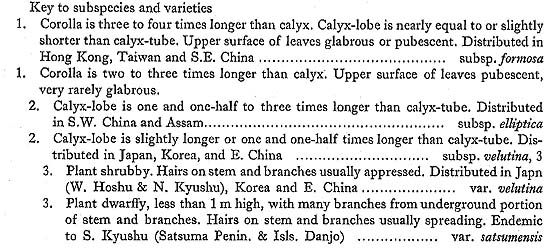
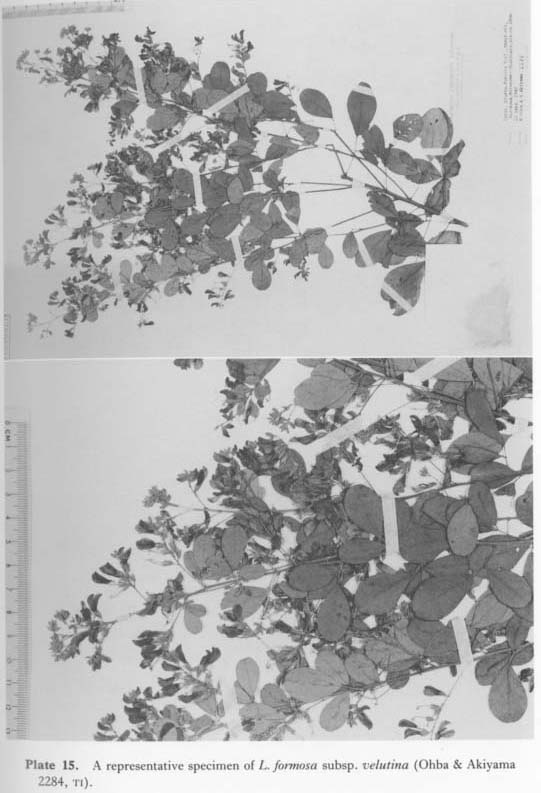
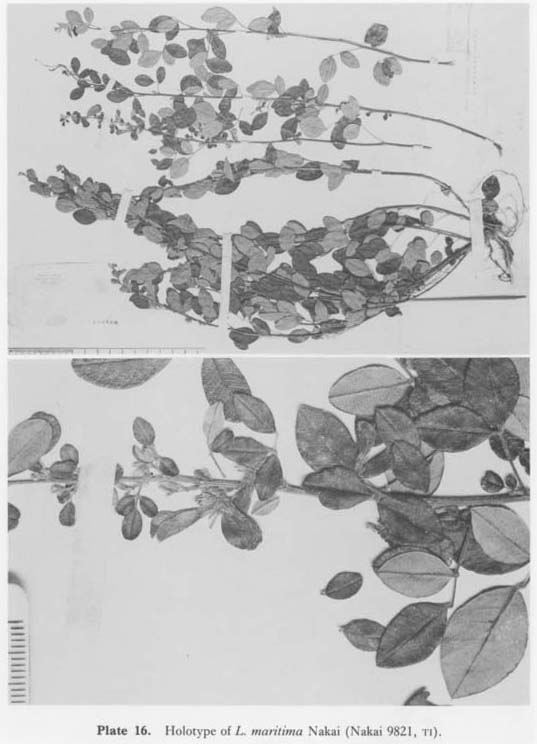
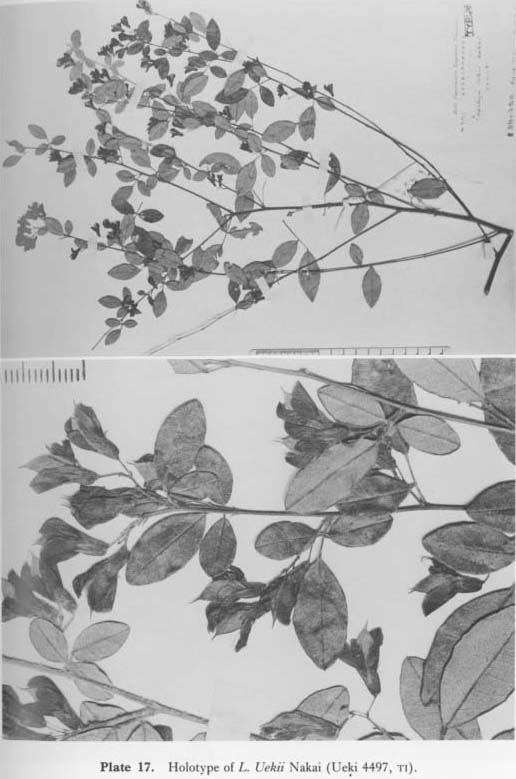
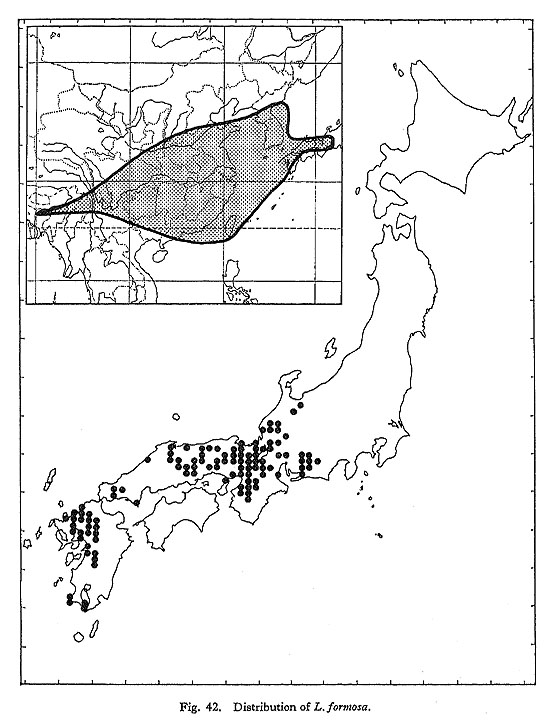
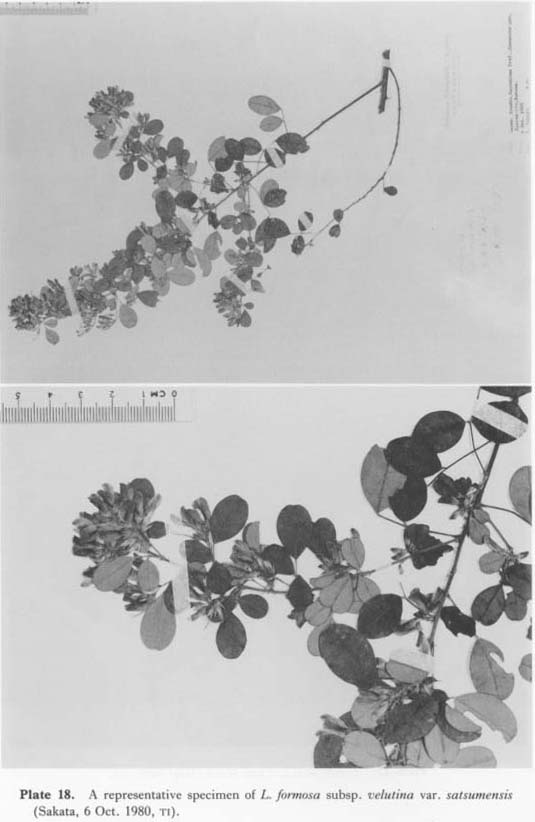
 .
.